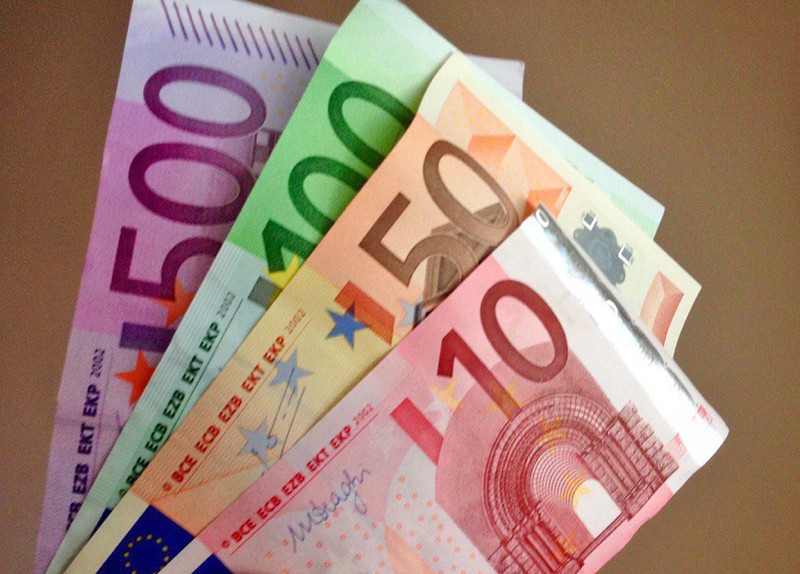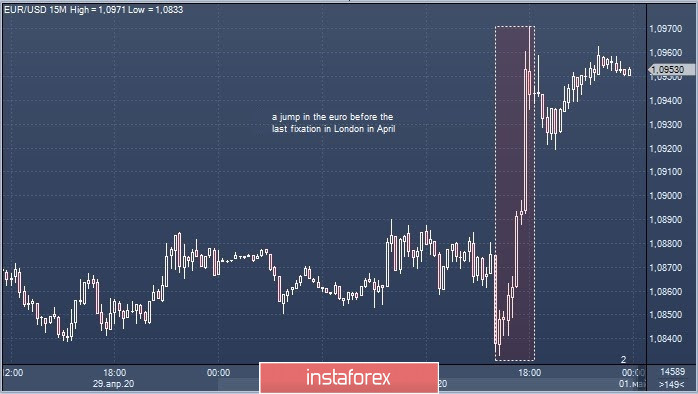
The meeting of the European Central Bank (ECB), held on the last day of April, did not cause drastic changes in the dynamics of the single currency. The "European" in the EUR/USD pair did not show much activity until the traders rushed frantically to buy the euro in order to balance their portfolios.
Analysts drew attention to the almost Olympic calm of the European currency when suddenly a tsunami occurred out of the blue at the end of the month, April 30 - a sharp surge in the price of EUR. This stirred up the market and alerted investors. It turned out that traders began a massive purchase of euros late in the evening before the last April fixation in London. Not more than an hour before fixation, the "European" currency has grown sharply, reaching two-week peaks.

At this height, the European currency remains on the first day of May. On the morning of Friday, May 1, the EUR/USD pair was in the range of 1.0949-1.0950. A day earlier, the pair did not leave the borders of the range 1.0880 - 1.0885. Now, the EUR/USD pair runs near 1.0962 - 1.0963 after making a sharp turn due to large-scale purchases.
Yesterday's event, similar to the price tsunami, became the main catalyst for the euro. Experts emphasize that the single currency did not show much activity after the ECB meeting. The experts explain the lack of a pronounced reaction from the euro by the fact that the regulator kept interest rates at the same level. The ECB explained its decision by the need to protect the single currency from the extremely negative consequences of the coronavirus pandemic (COVID-19). It can be recalled that the regulator left the deposit rate at -0.5%, and the key refinancing rate at 0.0%. European leaders believe that interest rates will stay at current or lower levels for a long time.
In addition, the regulator announced the readiness of large-scale purchases of government bonds, if necessary. It can be noted that the ECB launched an impressive package of incentives in March this year to mitigate the economic shock that swept the eurozone due to the pandemic. Last month, the regulator, acting as part of a stimulus package, actively acquired government bonds worth € 750 billion ($ 813 billion). Another innovation of the ECB was to reduce the cost of commercial banks to support lending.
The catalyst for the regulator's decision to maintain interest rates was depressing statistics on the eurozone economy. European leaders, primarily Christine Lagarde, head of the ECB, have promised to do everything possible to maintain the economy of the European region. However, fears of the leadership of the Eurobloc are caused by a possible sharp economic decline in the eurozone in the second quarter of 2020. According to preliminary forecasts, the range of the collapse of the eurozone GDP may range from 5% to 12%. Experts find it difficult to make more accurate calculations, since everything will depend on the duration of the quarantine measures.
This indicator, namely the Eurozone GDP, is under the inspection of economists. They record the strongest indicator decline in the entire history of observations. It can be recalled that the eurozone GDP dropped by 3.8% on a monthly basis in the first quarter of 2020, and fell immediately by 14.4% in annual terms. Experts note that economic activity in northern Europe declined more smoothly than in southern regions. According to analysts, the south of the eurozone will need more financial assistance in the near future than the north to prevent a long economic recession.
On the other hand, the unemployment rate in the Eurozone turned out to be relatively optimistic amid the pandemic, which slightly encouraged the market. According to current data, unemployment in the eurozone increased to just 7.4% in March 2020. It should be noted that it did not exceed 7.3% in February this year, that is, over the month the indicator grew slightly. According to experts, this was facilitated by measures to support small and medium-sized businesses, as well as subsidy programs for employee salaries.
Positive emotions were added to investors by information on inflation in the eurozone in April 2020. According to reports, the Eurozone's Consumer Price Index (CPI) slowed down to only 0.4% last month compared with 0.7% recorded in March. This exceeded the expectations of economists, who predicted its decline to 0.2%. According to analysts, the ECB has now no reason to worry about inflation.
Current economic indicators along with the expected decision of the ECB created a favorable background for the euro. However, the calm in the financial market was interrupted by a storm that traders staged before fixing in London. Such price changes negatively affected the dynamics of the eurocurrency, which is now gradually returning to normal. The EUR/USD pair strives for equilibrium, gradually leaving the roller coaster. Meanwhile, analysts say that the dollar in the EUR/USD pair is more stable than its rival. It also reacted relatively calmly to the decision of his regulator, the US Federal Reserve, to maintain rates. It can be noted that not one of the leading central banks, namely the Fed and the ECB, has made adjustments to its monetary policy. This fact alarms experts who expect rising pressure on risky assets in the near future.





















